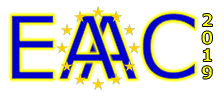Speaker
Description
Extreme field gradients intrinsic to relativistic laser-interactions with thin solid targets enable compact multi-MeV proton accelerators. The initial µm-scale acceleration phase is followed by ballistic proton propagation with negligible space-charge effects over millimeters to hundreds of centimeters to a site of analysis/application. The detected proton distribution can be influenced by the spatio-temporal intensity distribution in the laser focus, electron transport, plasma instabilities, as well as target geometry and surface properties.
Substantially extending this picture, our recent results show a critical influence of the mm-scale vacuum environment on the accelerated proton bunch, where residual gas molecules are ionized by the remnant laser light not absorbed into the target plasma but reflected or transmitted. In an experiment with µm-sized hydrogen jet targets, this effect lead to the counter-intuitive observation of laser near-field feature imprints in the detected proton beam profiles. Our results show that the remnant laser pulse induces a quasi-static deflecting field in the ionized residual background gas that serves as a memorizing medium and allows for asynchronous information transfer to the naturally delayed proton bunch. Occurring under typical experimental laser, target and vacuum conditions, all-optical imprinting needs to be taken into account for sensible interpretation of modulated proton beam profiles.

